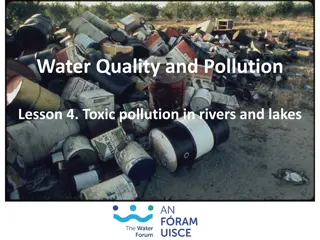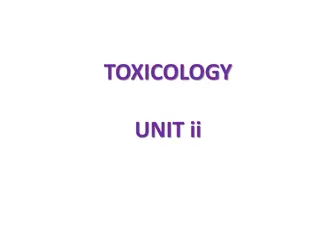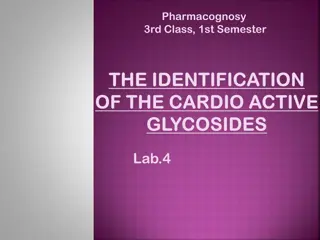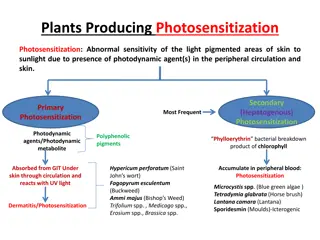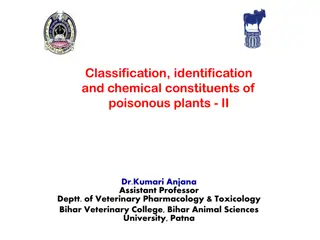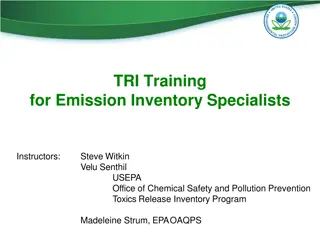Overview of Poisonous Plants: Classification, Identification, and Toxic Chemical Constituents
This detailed chapter delves into the classification, identification, and chemical constituents of poisonous plants, shedding light on natural toxins, alkaloids, and toxic principles. It covers the role of alkaloids in plant toxicity, highlighting specific types such as piperidine alkaloids, pyrrolizidine alkaloids, and more. The discussion also explores the toxicity of pyrrolizidine alkaloids found in plants like Senecio sp. and Crotalaria sp., providing valuable insights for those studying veterinary pharmacology and toxicology.
Download Presentation

Please find below an Image/Link to download the presentation.
The content on the website is provided AS IS for your information and personal use only. It may not be sold, licensed, or shared on other websites without obtaining consent from the author. Download presentation by click this link. If you encounter any issues during the download, it is possible that the publisher has removed the file from their server.
E N D
Presentation Transcript
Classification, identification and chemical constituents of poisonous plants Dr.Kumari Anjana Assistant Professor Deptt. of Veterinary Pharmacology & Toxicology Bihar Veterinary College, Bihar Animal Sciences University, Patna
Content of the chapter Introduction to Natural Toxins Classification of natural Toxins Alkaloids Piperidine Alkaloids Pyrrolizidine Alkaloids Pyridine Alkaloids Indole Alkaloids Quinolizidine Alkaloids Steroid Alkaloids Solanum type Veratrum type Polycyclic Diterpene alkaloids Indolizidine Alkaloids Tryptamine Alkaloids Tropane Alkaloids
Introduction to Toxic Principles of plants and their chemistry Plants are storehouse of chemicals diverse biological activities. Harmless and are necessary for the survival of both the plants and animal kingdoms. The simple sugar molecules- glucose- food chain in nature. The protoplasm consists of amino-acid essential for sustaining life. Primary metabolite: - glucose and amino acids- essential for life. secondarymetabolite: - variety of compounds other then Primary metabolites are produced by plants. Not essential for life. Plants toxins may be referred to as secondary plant metabolites which are toxic compounds.
Classification of Toxic Principles Classification on the basis of chemical constituents: Alkaloids Terpenes Glycosides Proteinaceous compounds Organic acids Resins and resinoids
Alkaloids Alkaloids ( alkali-like ) are compounds that contain nitrogen, usually in a heterocyclic ring, and are generally basic substances. They are usually bitter, and most are toxic. They are sub-classified on the basis of the chemical type of the nitrogen-containing heterocyclic ring.
Classification of Alkaloids Piperidine Alkaloids Pyrrolizidine Alkaloids Pyridine Alkaloids Indole Alkaloids Quinolizidine Alkaloids Steroid Alkaloids Solanum type Veratrum type Polycyclic Diterpene alkaloids Indolizidine Alkaloids Tryptamine Alkaloids Tropane Alkaloids
Pyrrolizidine Alkaloids The nucleus consists of two five-membered rings. Pyrrolizidine alkaloids are responsible for the toxicity of various plant like: Senecio sp. (tassy ragwort, common groundsel), Crotalaria sp., E. platagineum (Paterson s curse), Heliotropium sp. important in Australia It causes irreversible liver damage. Chemical constituents: monocrotaline, heliotrine, lasiocarpine, and senecionine.
Piperidine Alkaloids The most important piperidine alkaloids in animal reduction are coniine and related alkaloids found in Conium maculatum (poison hemlock). These alkaloids affect the central nervous system and are also teratogens. Plant ; Conium maculatum (hemlock). Chemical constituents: coniine
Pyridine Alkaloids Pyridine alkaloids is present in plant Nicotiana sp. Example: cultivated and wild tobacco. Chemical constituents: nicotine.
Indole Alkaloids Indole Alkaloids Indoles are derivatives of the amino acid tryptophan. Examples are the ergot alkaloids. The alkaloids such a perloloine present in tall fescue. Chemical constituents: 3-methylindole. It is an alkaloid implicated in bovine pulmonary emphysema.
Quinolizidine Alkaloids The quinolizidine nucleus consists of two six-membered rings. Lu-pines contain these alkaloids. It causes acute poisoning in sheep and teratogenic effects in calves (crooked calf disease).
Steroid Alkaloids Solanum type (e.g., salanidine) These are found in green potatoes, tomatoes, and nightshade. They are central nervous system poisons and cholinesterase inhibitors. Solanidine in potatoes has human health implications. Veratrum type (e.g., veratramine) False hellebore (Veratrum californicum) contains veratrum alkaloids that produce teratogenic effects in lambs (Cyclops lamb) and prolonged gestation in ewes. Death, a source of extensive sheep losses in the American West in the past, contains alkaloids of this type.
Polycyclic Diterpene alkaloids These complex alkaloids are found in Delphinium spp., commonly known as larkspurs. Larkspurs are responsible for more cattle losses in the U.S. than all other toxic plants combined. They cause acute central nervous system effects.
Indolizidine Alkaloids Indolizidine alkaloids, such as swainsonine, have been identified as the toxic components of Swainsona spp. In Australia and Astragalus spp. (locoweed) in the U.S. they are inhibitors of -mannosidase, re-cells. Slaframine is an indolizidine alkaloid produced on red clover by a fungus; it causes profuse salivation.
Tryptamine Alkaloids Tryptamine alkaloids are found in Phalaris tuberose, a forage grass grown in Australia. Phalaris poisoning results in acute neurological signs and chronic muscular incoordination.
Tropane Alkaloids Atropine, found in Datura spp. (Jimson weed), is an example of a tropane alkaloid. It has pronounced effects on the central nervous system.


